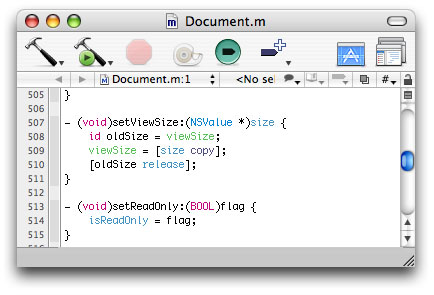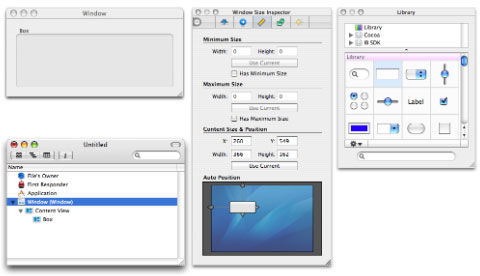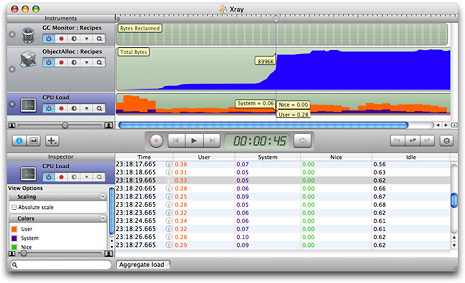|
Leopard is the sixth major version of
Mac OS X and it will be the most advanced and powerful version yet. For
users, it is full of new features and elegant user experience improvements
that will make it a joy to use. For developers, things get even better.
Leopard contains a cornucopia of cutting-edge new frameworks, streamlined
developer tools, new application technologies, and strong system-level
foundations. No matter what kind of developer you are, there’s something
new in the system that will feel tailor made just for you.
Get Started with
Leopard:
Leopard is scheduled to ship in the spring of 2007, so there is time for
you to start working with Leopard technologies well before your customers
get Leopard in their hands. When you do so, you will be more able to
provide your users with the latest and greatest features of Mac OS X
sooner.
You can begin
Leopard development with the Leopard Early Start Kit. The Kit provides ADC
Premier and Select members with advance access to essential Leopard
development resources, such as Leopard pre-release software, documentation
and code samples on the Leopard Dev Center, and WWDC 2006 Leopard session
videos through ADC on iTunes. If you are not already a Premier or Select
member, you can purchase the Leopard Early Start Kit now and begin your
Mac OS X Leopard development today.
An
Operating System Designed for Innovation:
The goal in adding
so many new developer technologies into Leopard is to make it easier for
you to create compelling, rich, and amazing new applications. Once upon a
time, a great application was defined by the functionality it provided.
Then, over time, the ease of use of an application became important—it
wasn’t enough just to get the job done, it had to be easy to do so. In
the last few years, the bar has been raised again. Now, a truly great
application isn’t just defined by its features and how easy it is to use
them, it’s also defined by how enjoyable it is to use.
By taking advantage of
the technologies in Leopard, you can add that extra level of detail that
makes your applications not just useful, but highly desirable. You can
give them that “wow” factor that will bring your customers back to
your application again and again.
You can begin
Leopard development with the Leopard
Early Start Kit. The Kit provides ADC Premier and Select members with
advance access to essential Leopard development resources, such as Leopard
pre-release software, documentation and code samples on the Leopard Dev
Center, and WWDC 2006, Leopard session videos through ADC on iTunes. If
you are not already a Premier or Select member, you can purchase
the Leopard Early Start Kit now and begin your Mac OS X Leopard
development today.
Getting to Know the
Leopard Technologies:
To help you get
acquainted with what’s coming in Leopard, ADC is presenting a series of
articles on Leopard technologies over the next several months. These
articles will take a deep look at Xcode, Objective-C 2.0, Core Animation,
Image Kit, Xrays, and much more.
We’re starting
the series with a broad overview of more than two dozen new and enhanced
technologies, tools and APIs that are coming in Leopard.
Developer Tools:
As a developer, the first
thing you should do when you install Leopard is take a look at the new
developer tools. You’re in for a real treat. We’ve put a lot of time
and effort into improving Xcode and Interface Builder so that it’s
easier to create and maintain large projects. We didn’t stop there,
however. In Leopard, we’re introducing the entirely new Xray and
Dashcode tools. Xray will let you take a look at how your application runs
like you’ve never been able to before. Dashcode lets you build Dashboard
widgets in no time flat.

Xcode 3.0:
Xcode
is Apple’s Integrated Development Environment (IDE) for creating any
code for Mac OS X. It’s the centerpiece application of your workday.
Because it’s such an important part of the development process, we’ve
spent a lot of time making the latest version of Xcode streamlined and
faster, in order to make you more productive. The first place you’ll
notice Xcode’s improvements is in the text editor. Code folding, scope
highlighting, and iChat-like message bubbles that clearly mark build
warnings and errors as well as breakpoints, are some of the key editing
enhancements.

To help you access
documentation while you work, the new Research Assistant gives you a
heads-up display of relevant information about symbols in your code in a
convenient, small panel. If you need more information, you can simply
click for more detail and the full documentation window will open. And, to
help you experiment with your code, Project Snapshot lets you record the
state of your project and snap back to that state at any point in the
future. This lets you quickly try out an idea without having to check
things back into your projects source code repository.

Interface Builder 3.0:
Interface Builder
is the intuitive, easy-to-use tool for creating and editing user interface
resources files (nib files). These files represent a set of interface
objects and their relationships, as well as their connections to your
application’s logic. In Leopard, Interface Builder has been thoroughly
modernized and updated, both to support the new interface technologies in
Leopard as well as to make the applications you develop easier than ever
to build.

In addition to laying out
your user interface, Interface Builder now lets you add impressive Core
Animation-based behaviors to your application, such as the iChat sliding
list view or Keynote-style transitions, in a matter of minutes. And it
even has features that improve the ability to see differences between
versions of your interface. It also comes with a new Interface Builder Kit
API for plug-in developers.

Xray:
Xray is a
brand-new, timeline-based performance visualization tool that gives you
the ability to see how your application works like you’ve never been
able to do before. It lets you watch CPU, disk I/O, memory usage, garbage
collection, events, and more in the form of graphs tied to time.
For example,
you can track UI events in
real-time and see how they affect I/O activity and CPU load at the same
time. And, once the data has been collected, you can scan back and forth
through your application’s run and see exactly what occurred, and when.

Xray builds on top
of the open source DTrace utility. DTrace is a comprehensive command-line
monitoring utility that can probe almost any aspect of system performance.
It comes with a large set of tools that cover most general aspects of
system performance, including both kernel and user code, with near-zero
overhead. If there is an aspect of the system that you want to track that
isn’t already supported, you can create your own tool using the D
programming language.

Dashcode:
Dashcode is
Apple’s new Dashboard widget development environment. It offers a
built-in debugger and all the text editing features of a professional IDE.
You can set and view breakpoints as well as track your widget’s
execution through its JavaScript source code.
Dashcode is geared
for all levels of Widget developers. You can start out with a prebuilt
template and modify it to your needs, or get deep into the JavaScript, CSS,
and HTML that defines all the aspects of how a Widget looks and works.
Application
Technologies:
Leopard brings a
multitude of improvements and additions to the Carbon and Cocoa
application frameworks. The most visible of these is the new Core
Animation framework which makes creating compelling interfaces much
easier. Not as obvious, but no less important is the addition of garbage
collection to Objective-C, new controls for both Carbon and Cocoa
applications, full-stack 64-bit capabilities, and a factor of ten increase
in the performance of Core Data.

Core Animation:
Core Animation is a
Cocoa framework for creating animated, composited, and dynamic user
interfaces with a simple and approachable programming model. Quartz,
OpenGL, and Core Image enable the fluid animations it creates, yet it
exposes a familiar NSView-style hierarchy that mirrors that of the
Application Kit view architecture. Many of the new user-level features in
Leopard, such as Spaces and Time Machine, utilize Core Animation to
perform their user interface transitions.
Using Core
Animation, your application can effortlessly provide a cinematic user
experience to your users. You’ll be able to smoothly move user interface
elements around the screen, fade them in and out, and add effects with
just a few lines of code. In addition to Quartz and Core Image, you can
also leverage Core Video and Quartz Composer to achieve a wide range of
visual results. You can direct Core Animation from either code or by using
Interface Builder.

Objective-C 2.0:
Objective-C is an
ANSI C compatible language with dynamic object-oriented extensions. It
combines the power of Smalltalk-style message passing with the performance
and native system-level access of C. From the start, the abilities of Obj-C
have fueled the power of the Cocoa framework. Now in Leopard, the
Objective-C runtime has been updated to include a thoroughly modern and
high performance garbage collection system, making memory management a
thing of the past.
Also new in
Objective-C 2.0 are a set of syntax improvements, including property
accessors and fast enumeration. These improvements bring the language
up-to-date with the expectations of today’s programmers. And, since
Objective-C 2.0 is compatible with existing Objective-C source, you can
adopt it at your own pace.
IChat
Integration:
Instant messaging
has become an essential tool for users to communicate and collaborate. In
Leopard, the ability to collaborate has been taken to a new level. In an
iChat session, users will be able to use iChat Theatre to present data
from another application, such as iPhoto or Keynote, as part of a video
conference. The applications you create will also be able to integrate
with iChat in the same way using the Instant Messaging framework via the
Core Video and Core Audio APIs. Once integrated, the Instant Messaging
framework will automatically compress the content, using the H.264 codec,
and send it across the network to the remote user’s display.
Another new feature
in the Instant Messaging framework is the ability to manage presence. This
means that your application can query the iChat status of the user,
indicating whether they are available or busy and what their status
message is, as well as manipulate it. As well, it will give access to the
buddy list. If you are building an application which allows users to
collaborate on content, you could use the APIs to notify users when their
friends or co-workers were online.
Resolution
Independence:
The old assumption
that displays are 72dpi has been rendered obsolete by advances in display
technology. Macs now ship with displays that sport native resolutions of
100dpi or better. Furthermore, the number of pixels per inch will continue
to increase dramatically over the next few years. This will make displays
crisper and smoother, but it also means that interfaces that are
pixel-based will shrink to the point of being unusable. The solution is to
remove the 72dpi assumption that has been the norm. In Leopard, the
system, including the Carbon and Cocoa frameworks, will be able to draw
user interface elements using a scale factor. This will let the user
interface maintain the same physical size while gaining resolution and
crispness from high dpi displays.
The introduction of
resolution independence may mean that there is work that you’ll need to
do in order to make your application look as good as possible. For modern
Cocoa and Carbon applications, most of the work will center around
raster-based resources. For older applications that use Quick Draw, more
work will be required to replace Quick Draw-based calls with Quartz ones.
Calendar Store:
The Calendar Store
framework provides access to a user’s iCal calendar data. Using the
framework, you can fetch calendars, events, and tasks from iCal’s data
storage. This allows your application to work with the same data as iCal,
Mail, and any other application that a manager uses to interact with their
schedule and to-do items.
Graphics & Media:
Each release of Mac
OS X builds on and expands the capabilities of QuickTime, Quartz, OpenGL,
and Core Audio, and Leopard is no exception. The Graphics & Media
frameworks in Leopard enable all of the higher-level application
technologies, and expand them in new and exciting ways.
Image Kit:
Image Kit is a new
and robust Cocoa-based framework powered by Core Image and Core Animation.
It makes available powerful imaging services that can be easily
incorporated into your application. It provides functionality for finding,
browsing, and viewing images in a collection. You can rearrange images in
a group view as well as rotate individual images. Image Kit also provides
a gateway for browsing, previewing, and setting Core Image filters on an
image.
OpenGL Improvements:
OpenGL is the
industry-standard API for developing portable, interactive 2D and 3D
applications. Mac OS X has supported OpenGL from the outset and in Leopard
it supports the latest OpenGL 2.1 specification which adds pixel buffer
objects, color managed texture images in the sRGB color space, and
improvements in the shader programming API.
Leopard also
provides a dramatic increase in OpenGL performance by offloading CPU-based
processing onto another thread which can then run on a separate CPU core
feeding the GPU. This can increase, or in some cases, approach double the
performance of OpenGL-based applications.
QuickTime
Improvements:
Working with video using
QuickTime has long been a strength of Mac OS X. Now, it’s as easy to
build video capture into your application as it is to work with
pre-recorded video. By using the QTKit Capture API, you can capture video
from an iSight, USB (VDC) and FireWire (IIDC) devices, and DV cameras. The
API even lets you output to multiple outputs.
QuickTime’s
plumbing is receiving significant upgrades in Leopard. There have been
significant enhancements in handling the H.264 encoding. Also, transparent
alpha layers, an optional part of the H.264 specification, are now
supported in H.264-based QuickTime movies. And finally, QuickTime supports
64-bit. However, the functionality for 64-bit QuickTime is only provided
via the QTKit framework. The current C-based QuickTime API will only be
supported in 32-bit mode.
Picture Taker Panel:
Mac OS X has used images
in many applications for a while. For example, when you first set up Mac
OS X, it will take your picture if you have a camera built-in or attached.
Leopard exposes the ability to take a user’s picture to any application
using the Picture Taker Panel. It will handle all the details of whether a
user has a camera built-in or plugged in as well as providing a flash. In
short, you can open the Picture Taker Panel and, once the user is
satisfied with their picture, your application will be handed a picture
return value.
OS Foundations:
The heart of Mac OS X,
the Open Source Mach- and BSD-based UNIX layer known as Darwin, continues
to see improvements in Leopard. The latest Mac hardware brings more
processing power, more cores, and more memory than ever before. The kernel
in Leopard has been updated to take advantage of this new hardware.
Leopard certainly
won’t be UNIX in name only. Apple will submit Leopard and Leopard Server
to The Open Group for certification against the UNIX ‘03 product
standard.
64-bit:
First implemented at the
UNIX level in Tiger, Leopard brings complete 64-bit support to all of Mac
OS X’s application frameworks. Using either the Carbon or Cocoa
frameworks, you can create applications that can address extremely large
data sets, up to 128TB using the current Intel-based CPUs. The 64-bit
model used in Mac OS X is known as LP64 and is the same model used by
other 64-bit UNIX systems from Sun and SGI as well as 64-bit Linux.
And there's more:
the 64-bit support in Mac OS X maintains the ability to run current 32-bit
applications. On Intel processors, 64-bit applications have an increased
number of CPU registers available in 64-bit mode, and they may run faster
than their 32-bit counterparts.
Information
Technology:
Mac OS X and Mac OS X
Server provide a rich set of features and enable a rich set of solutions.
Each version of Mac OS X Server has made impressive leaps in functionality
while offering easy to use management tools. Leopard provides the most
powerful version of Server, built on a host of open source products and
tools that make it a server for anyone from sysadmins to IT managers to
developers maintaining a lab of test and development Macs.
Best of all,
Leopard Server is a superset of Leopard. That means it uses the same
kernel and supports the same 64-bit capabilities. Building on top of
Leopard’s 64-bit frameworks, all of the services in Leopard Server are
64-bit enabled. This means that they will be able to take advantage of
massive amounts of memory as well as enjoy performance increases on
Intel-based 64-bit processors.
Open Directory
4:
Leopard Server
ships with an updated version of Open Directory that supports LDAP
proxying, cross-domain authorization, cascading replication, and replica
sets. It even supports RADIUS authentication for Airport base stations
deployed across your office or campus.
Calendaring Server:
The Darwin Calendar
Server allows users to collaboratively share calendars across an
organization. It provides a shared location to store their schedules and
sync them between machines. It also allows users to send each other
invitations to events. Implemented using the CalDAV protocol, it supports
multiple calendaring clients, including Leopard’s iCal, Mozilla’s
Sunbird, OSAF’s Chandler, and Microsoft Outlook.
Ruby on Rails:
Leopard Server features a
built-in installation of the powerful and productive Ruby on Rails web
application framework. Ruby on Rails is a full stack framework optimized
for sustainable productivity. Leopard Server will ship with Mongrel for
simplified development and deployment of web-based applications.
References:
http://developer.apple.com/leopard/overview/
|